5.5: Fungi
- Page ID
- 83003
\( \newcommand{\vecs}[1]{\overset { \scriptstyle \rightharpoonup} {\mathbf{#1}} } \)
\( \newcommand{\vecd}[1]{\overset{-\!-\!\rightharpoonup}{\vphantom{a}\smash {#1}}} \)
\( \newcommand{\dsum}{\displaystyle\sum\limits} \)
\( \newcommand{\dint}{\displaystyle\int\limits} \)
\( \newcommand{\dlim}{\displaystyle\lim\limits} \)
\( \newcommand{\id}{\mathrm{id}}\) \( \newcommand{\Span}{\mathrm{span}}\)
( \newcommand{\kernel}{\mathrm{null}\,}\) \( \newcommand{\range}{\mathrm{range}\,}\)
\( \newcommand{\RealPart}{\mathrm{Re}}\) \( \newcommand{\ImaginaryPart}{\mathrm{Im}}\)
\( \newcommand{\Argument}{\mathrm{Arg}}\) \( \newcommand{\norm}[1]{\| #1 \|}\)
\( \newcommand{\inner}[2]{\langle #1, #2 \rangle}\)
\( \newcommand{\Span}{\mathrm{span}}\)
\( \newcommand{\id}{\mathrm{id}}\)
\( \newcommand{\Span}{\mathrm{span}}\)
\( \newcommand{\kernel}{\mathrm{null}\,}\)
\( \newcommand{\range}{\mathrm{range}\,}\)
\( \newcommand{\RealPart}{\mathrm{Re}}\)
\( \newcommand{\ImaginaryPart}{\mathrm{Im}}\)
\( \newcommand{\Argument}{\mathrm{Arg}}\)
\( \newcommand{\norm}[1]{\| #1 \|}\)
\( \newcommand{\inner}[2]{\langle #1, #2 \rangle}\)
\( \newcommand{\Span}{\mathrm{span}}\) \( \newcommand{\AA}{\unicode[.8,0]{x212B}}\)
\( \newcommand{\vectorA}[1]{\vec{#1}} % arrow\)
\( \newcommand{\vectorAt}[1]{\vec{\text{#1}}} % arrow\)
\( \newcommand{\vectorB}[1]{\overset { \scriptstyle \rightharpoonup} {\mathbf{#1}} } \)
\( \newcommand{\vectorC}[1]{\textbf{#1}} \)
\( \newcommand{\vectorD}[1]{\overrightarrow{#1}} \)
\( \newcommand{\vectorDt}[1]{\overrightarrow{\text{#1}}} \)
\( \newcommand{\vectE}[1]{\overset{-\!-\!\rightharpoonup}{\vphantom{a}\smash{\mathbf {#1}}}} \)
\( \newcommand{\vecs}[1]{\overset { \scriptstyle \rightharpoonup} {\mathbf{#1}} } \)
\( \newcommand{\vecd}[1]{\overset{-\!-\!\rightharpoonup}{\vphantom{a}\smash {#1}}} \)
\(\newcommand{\avec}{\mathbf a}\) \(\newcommand{\bvec}{\mathbf b}\) \(\newcommand{\cvec}{\mathbf c}\) \(\newcommand{\dvec}{\mathbf d}\) \(\newcommand{\dtil}{\widetilde{\mathbf d}}\) \(\newcommand{\evec}{\mathbf e}\) \(\newcommand{\fvec}{\mathbf f}\) \(\newcommand{\nvec}{\mathbf n}\) \(\newcommand{\pvec}{\mathbf p}\) \(\newcommand{\qvec}{\mathbf q}\) \(\newcommand{\svec}{\mathbf s}\) \(\newcommand{\tvec}{\mathbf t}\) \(\newcommand{\uvec}{\mathbf u}\) \(\newcommand{\vvec}{\mathbf v}\) \(\newcommand{\wvec}{\mathbf w}\) \(\newcommand{\xvec}{\mathbf x}\) \(\newcommand{\yvec}{\mathbf y}\) \(\newcommand{\zvec}{\mathbf z}\) \(\newcommand{\rvec}{\mathbf r}\) \(\newcommand{\mvec}{\mathbf m}\) \(\newcommand{\zerovec}{\mathbf 0}\) \(\newcommand{\onevec}{\mathbf 1}\) \(\newcommand{\real}{\mathbb R}\) \(\newcommand{\twovec}[2]{\left[\begin{array}{r}#1 \\ #2 \end{array}\right]}\) \(\newcommand{\ctwovec}[2]{\left[\begin{array}{c}#1 \\ #2 \end{array}\right]}\) \(\newcommand{\threevec}[3]{\left[\begin{array}{r}#1 \\ #2 \\ #3 \end{array}\right]}\) \(\newcommand{\cthreevec}[3]{\left[\begin{array}{c}#1 \\ #2 \\ #3 \end{array}\right]}\) \(\newcommand{\fourvec}[4]{\left[\begin{array}{r}#1 \\ #2 \\ #3 \\ #4 \end{array}\right]}\) \(\newcommand{\cfourvec}[4]{\left[\begin{array}{c}#1 \\ #2 \\ #3 \\ #4 \end{array}\right]}\) \(\newcommand{\fivevec}[5]{\left[\begin{array}{r}#1 \\ #2 \\ #3 \\ #4 \\ #5 \\ \end{array}\right]}\) \(\newcommand{\cfivevec}[5]{\left[\begin{array}{c}#1 \\ #2 \\ #3 \\ #4 \\ #5 \\ \end{array}\right]}\) \(\newcommand{\mattwo}[4]{\left[\begin{array}{rr}#1 \amp #2 \\ #3 \amp #4 \\ \end{array}\right]}\) \(\newcommand{\laspan}[1]{\text{Span}\{#1\}}\) \(\newcommand{\bcal}{\cal B}\) \(\newcommand{\ccal}{\cal C}\) \(\newcommand{\scal}{\cal S}\) \(\newcommand{\wcal}{\cal W}\) \(\newcommand{\ecal}{\cal E}\) \(\newcommand{\coords}[2]{\left\{#1\right\}_{#2}}\) \(\newcommand{\gray}[1]{\color{gray}{#1}}\) \(\newcommand{\lgray}[1]{\color{lightgray}{#1}}\) \(\newcommand{\rank}{\operatorname{rank}}\) \(\newcommand{\row}{\text{Row}}\) \(\newcommand{\col}{\text{Col}}\) \(\renewcommand{\row}{\text{Row}}\) \(\newcommand{\nul}{\text{Nul}}\) \(\newcommand{\var}{\text{Var}}\) \(\newcommand{\corr}{\text{corr}}\) \(\newcommand{\len}[1]{\left|#1\right|}\) \(\newcommand{\bbar}{\overline{\bvec}}\) \(\newcommand{\bhat}{\widehat{\bvec}}\) \(\newcommand{\bperp}{\bvec^\perp}\) \(\newcommand{\xhat}{\widehat{\xvec}}\) \(\newcommand{\vhat}{\widehat{\vvec}}\) \(\newcommand{\uhat}{\widehat{\uvec}}\) \(\newcommand{\what}{\widehat{\wvec}}\) \(\newcommand{\Sighat}{\widehat{\Sigma}}\) \(\newcommand{\lt}{<}\) \(\newcommand{\gt}{>}\) \(\newcommand{\amp}{&}\) \(\definecolor{fillinmathshade}{gray}{0.9}\)Kingdom Fungi
- Please read and watch the following Learning Resources
- Reading the material for understanding, and taking notes during videos, will take approximately 90 minutes.
- Optional Activities are embedded.
- To navigate to the next section, use the Contents menu at the top of the page OR the right arrow on the side of the page.
- If on a mobile device, use the Contents menu at the top of the page OR the links at the bottom of the page.
- List the characteristics of fungi
- Describe the composition of the mycelium
- Describe the mode of nutrition of fungi
- Explain sexual and asexual reproduction in fungi
- Describe the role of fungi in the ecosystem
Introduction to Fungi
This 2.5-minute video introduces organisms in the kingdom Fungi.
Question after watching: Are fungi unicellular or multicellular?
The word fungus comes from the Latin word for mushrooms. Indeed, the familiar mushroom is a reproductive structure used by many types of fungi. However, there are also many fungi species that do not produce mushrooms at all (Figure \(\PageIndex{1}\)). Being eukaryotes, a typical fungal cell contains a nucleus and many membrane-bound organelles. The kingdom Fungi (pronounced either fun-guy or fun-jie) includes an wide variety of living organisms collectively referred to as Eucomycota, or true Fungi. While scientists have identified about 100,000 species of fungi, this is only a fraction of the 1.5 million species of fungus likely present on Earth. Edible mushrooms, yeasts, black mold, and the producer of the antibiotic penicillin, Penicillium notatum, are all members of the kingdom Fungi, which belongs to the domain Eukarya.
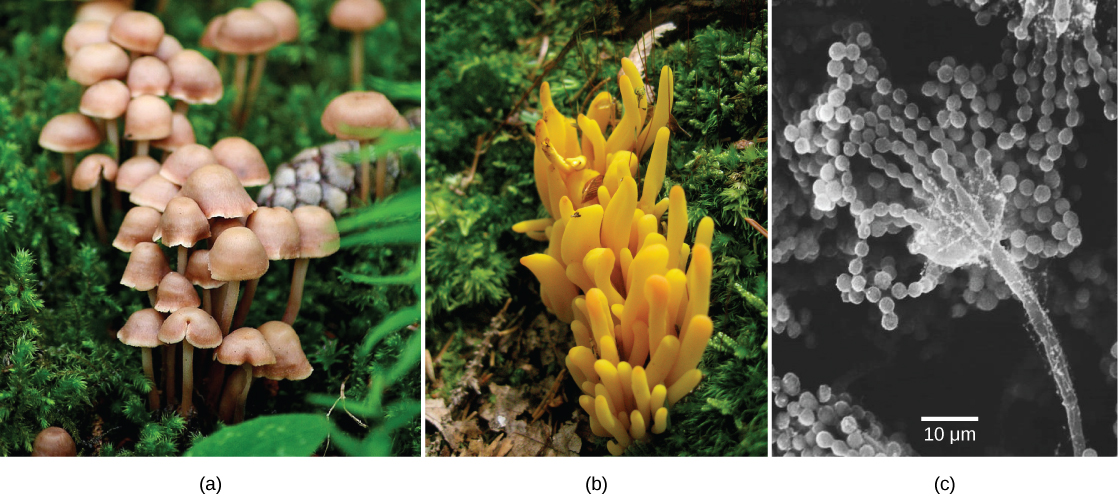
Although humans have used yeasts and multicellular fungi since prehistoric times. Until recently, the biology of fungi was poorly understood. Up until the mid-20th century, many scientists classified fungi as plants. Fungi, like plants, are sessile, meaning they are seemingly rooted in place. Their mode of nutrition was poorly understood. Then came the field of mycology: the scientific study of fungi.
Most fungi are multicellular organisms. They display two distinct morphological stages: vegetative and reproductive. The vegetative stage consists of a tangle of slender thread-like structures called hyphae (singular, hypha), whereas the reproductive stage can be more conspicuous (such as what is seen in (Figure \(\PageIndex{1}\)). The mass of hyphae is a mycelium (Figure \(\PageIndex{2}\)). It can grow on a surface, in soil or decaying material, in a liquid, or even on living tissue.
The vegetative body of a fungus is a unicellular or multicellular thallus, meaning a collection of cells or tissues not structured into organs. Dimorphic fungi can change from a unicellular to multicellular state depending on environmental conditions. Unicellular fungi are generally referred to as yeasts, including Saccharomyces cerevisiae (baker’s yeast) and Candida species (the agents of thrush, a common fungal infection) (Figure \(\PageIndex{3}\)).
Although individual hyphae must be observed under a microscope, the mycelium of a fungus can be very large. The giant Armillaria solidipes (honey mushroom) is considered the largest organism on Earth, spreading across more than 2,000 acres of underground soil in eastern Oregon; it is estimated to be at least 2,400 years old.
Based on fossil evidence, fungi appeared in the pre-Cambrian era, about 450 million years ago. Molecular biology analysis of the fungal genome suggests that fungi are more closely related to animals than plants. They are a polyphyletic group of organisms that share characteristics, rather than sharing a single common ancestor.


Evolutionary History of Fungi
The kingdom Fungi contains five major phyla that were established using molecular data or information about their mode of sexual reproduction. Fungi that reproduce without a sexual cycle, and that are hard to classify according to their DNA, are placed for convenience in a sixth group called a “form phylum.” The form phylum is sort of like a placeholder bin where fungi that don’t seem to fit anywhere else can be categorized until we learn more about them. Not all mycologists agree with this scheme.
The five true phyla of fungi are the Chytridiomycota (Chytrids), the Zygomycota (conjugated fungi), the Ascomycota (sac fungi), the Basidiomycota (club fungi) and the recently described Phylum Glomeromycota (Figure \(\PageIndex{4}\)). An older classification scheme grouped fungi that strictly use asexual reproduction into Deuteromycota, a group that is no longer in use.
Note: “-mycota” is used to designate a phylum while “-mycetes” formally denotes a class or is used informally to refer to all members of the phylum.
Chytridiomycota - The Chytrids
Chytridiomycota (chytrids) are considered the most primitive group of fungi. The ecological habitat and cell structure of chytrids have much in common with protists. The evolutionary record shows that the first recognizable chytrids appeared during the late pre-Cambrian period, more than 500 million years ago. Like all fungi, chytrids have chitin in their cell walls, but one group of chytrids has both cellulose and chitin in the cell wall. Most chytrids are unicellular; a few form multicellular organisms and hyphae, which have no septa between cells (coenocytic). They are mostly aquatic, and their gametes are the only fungal cells known to have flagella. They reproduce both sexually and asexually; the asexual spores are called zoospores.
Zygomycota - The Conjugated Fungi
Zygomycota (conjugated fungi) produce non-septated hyphae with many nuclei. Hyphae are the primary cell bodies of fungal organisms. Zygomycetes have a thallus of coenocytic hyphae in which the nuclei are haploid when the organism is in the vegetative stage. The fungi usually reproduce asexually by producing sporangiospores (Figure \(\PageIndex{5}\)). The black tips of bread mold are the swollen sporangia packed with black spores (Figure \(\PageIndex{6}\)). When spores land on a suitable substrate, they germinate and produce a new mycelium. Their hyphae fuse during sexual reproduction, under unfavorable conditions to produce a zygospore in a zygosporangium.
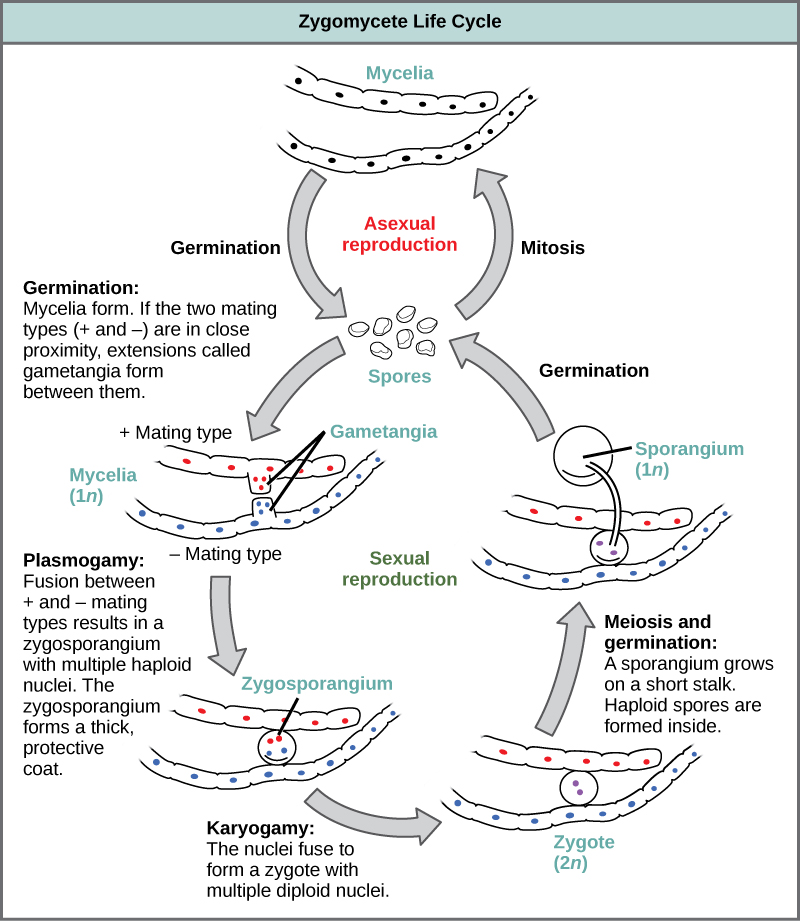
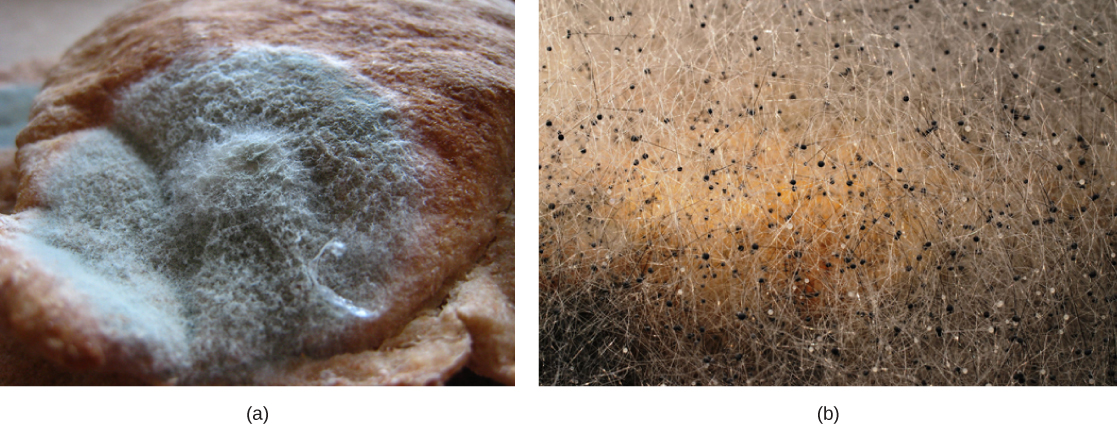
They include the familiar bread mold, Rhizopus stolonifer, which rapidly propagates on the surfaces of breads, fruits, and vegetables. Most species are saprobes, living off decaying organic material; a few are parasites, particularly of insects. Zygomycetes play a considerable commercial role. The metabolic products of other species of Rhizopus are intermediates in the synthesis of semi-synthetic steroid hormones.
Ascomycota - The Sac Fungi
The majority of known fungi belong to the Phylum Ascomycota, which is characterized by the formation of an ascus (plural, asci), a sac-like structure that contains haploid ascospores. Many ascomycetes are of commercial importance. Some play a beneficial role, such as the yeasts used in baking, brewing, and wine fermentation, plus truffles and morels, which are held as gourmet delicacies. Aspergillus oryzae is used in the fermentation of rice to produce sake. Other ascomycetes parasitize plants and animals, including humans. For example, fungal pneumonia poses a significant threat to AIDS patients who have a compromised immune system. Ascomycetes not only infest and destroy crops directly; they also produce poisonous secondary metabolites that make crops unfit for consumption. Filamentous ascomycetes produce hyphae divided by perforated septa, allowing streaming of cytoplasm from one cell to the other. Conidia and asci, which are used respectively for asexual and sexual reproductions, are usually separated from the vegetative hyphae by blocked (non-perforated) septa.
Ascomycota (sac fungi) form spores in sacs called asci (millions of which fuse together into ascocarps) during sexual reproduction (Figure \(\PageIndex{7}\)). However, this name was obtained because the sexual form attracted the human eye. Asexual reproduction is their most common form of reproduction.
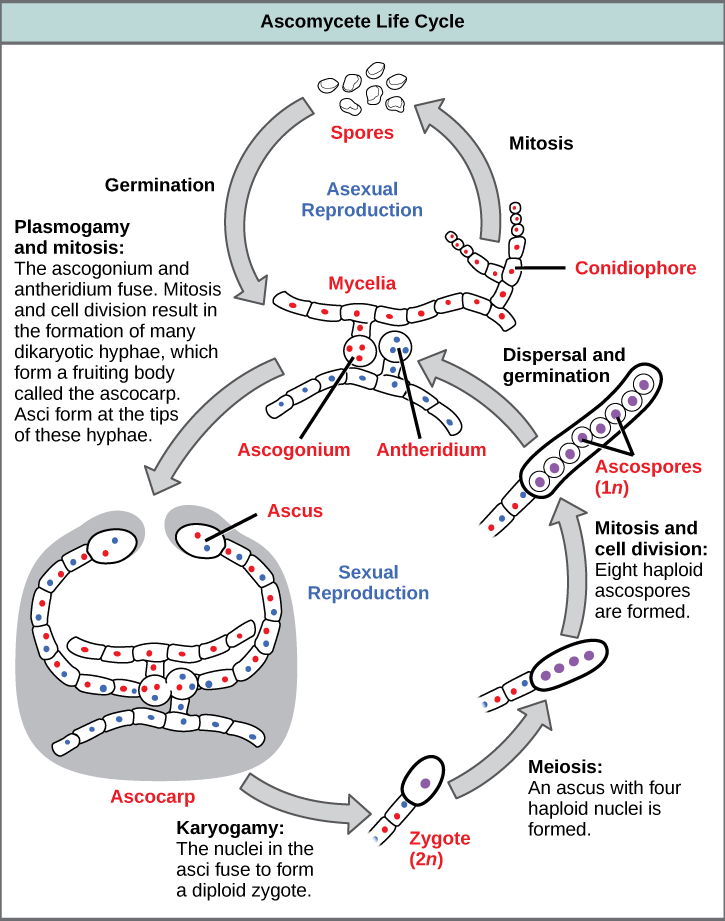
Basidiomycota - The Club Fungi
Basidiomycota (club fungi) produce showy fruiting bodies that contain basidia in the form of clubs known as basiciocarps (the clubs under the mushroom bell shape in what looks like gills or sheets. Magnified, these sheets have club-like protrusions). These mushroom-producing basidiomyces are sometimes referred to as “gill fungi” because of the presence of gill-like structures on the underside of the cap. The “gills” are actually compacted hyphae on which the basidia are borne. Spores are stored in the basidia.
This group also includes shelf fungus, which cling to the bark of trees like small shelves. In addition, the basidiomycota includes smuts and rusts, which are important plant pathogens; toadstools, and shelf fungi stacked on tree trunks. Most edible fungi belong to the Phylum Basidiomycota; however, some basidiomycetes produce deadly toxins. For example, Cryptococcus neoformans causes severe respiratory illness.
The lifecycle of basidiomycetes includes alternation of generations (Figure \(\PageIndex{8}\)). Spores are generally produced through sexual reproduction, rather than asexual reproduction. The club-shaped basidium carries spores called basidiospores. In the basidium, nuclei of two different mating strains fuse (karyogamy), giving rise to a diploid zygote that then undergoes meiosis. The haploid nuclei migrate into basidiospores, which germinate and generate monokaryotic hyphae. The mycelium that results is called a primary mycelium. Mycelia of different mating strains can combine and produce a secondary mycelium that contains haploid nuclei of two different mating strains. This is the dikaryotic stage of the basidiomyces lifecyle and and it is the dominant stage. Eventually, the secondary mycelium generates a basidiocarp, which is a fruiting body that protrudes from the ground—this is what we think of as a mushroom. The basidiocarp bears the developing basidia on the gills under its cap.
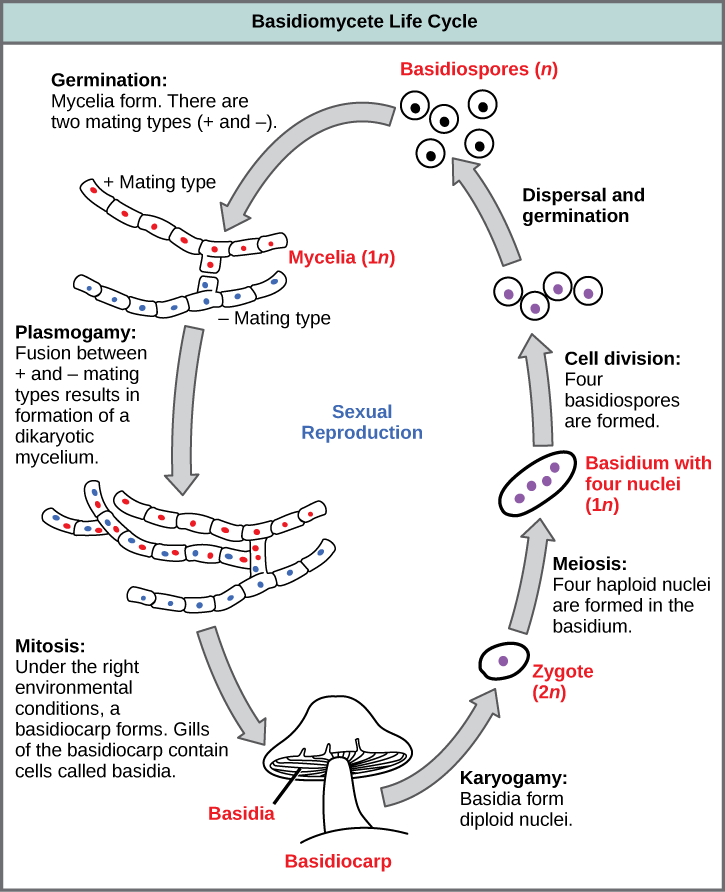
Glomeromycota
The Glomeromycota is a newly established phylum which comprises about 230 species that all form mycorrhizal relationships with the roots of plants. Fossil records indicate that trees and their root symbionts share a long evolutionary history. It appears that all members of this family form arbuscular mycorrhizae: the hyphae interact with the root cells forming a mutually beneficial association where the plants supply the carbon source and energy in the form of carbohydrates to the fungus, and the fungus supplies essential minerals from the soil to the plant.
The glomeromycetes do not reproduce sexually and do not survive without the presence of plant roots. Although they have coenocytic hyphae like the zygomycetes, they do not form zygospores. DNA analysis shows that all glomeromycetes probably descended from a common ancestor, making them a monophyletic lineage.
Asexual Ascomycota and Basidiomycota
Fungi that have no known sexual cycle were classified in the form phylum Deuteromycota. That phylum no longer exists. Present classification now puts these fungi into the phyla Ascomycota and Basidiomycota based on evolutionary relationships.
In this 9-minute lecture, the characteristics, reproduction, and categories of the kingdom Fungi are explained.
Question after watching: Mr. Anderson says that we probably have more in common in our lifestyle with fungi than with plants. What sort of evidence can you find to support this assertion?
This 6.5-minute video provides an evolutionary history of fungi.
Question after watching: This video suggests that fungi were critical to the evolution of plants and animals. How?
Mycologists are biologists who study fungi. Mycology is a branch of microbiology, and many mycologists start their careers with a degree in microbiology. To become a mycologist, a bachelor's degree in a biological science (preferably majoring in microbiology) and a master's degree in mycology are minimally necessary. Mycologists can specialize in taxonomy and fungal genomics, molecular and cellular biology, plant pathology, biotechnology, or biochemistry. Some medical microbiologists concentrate on the study of infectious diseases caused by fungi (mycoses). Mycologists collaborate with zoologists and plant pathologists to identify and control difficult fungal infections, such as the devastating chestnut blight, the mysterious decline in frog populations in many areas of the world, or the deadly epidemic called white-nose syndrome, which has decimated bats in eastern North America and spreading west at a rapid rate.
Government agencies hire mycologists as research scientists and technicians to monitor the health of crops, national parks, and national forests. Mycologists are also employed in the private sector by companies that develop chemical and biological control products or new agricultural products, and by companies that provide disease control services. Because of the key role played by fungi in the fermentation of alcohol and the preparation of many important foods, scientists with a good understanding of fungal physiology routinely work in the food technology industry. Oenology, the science of winemaking, relies not only on the knowledge of grape varietals and soil composition but also on an understanding of the characteristics of the wild yeasts that thrive in different winemaking regions. It is possible to purchase yeast strains isolated from specific grape-growing regions. The great French chemist and microbiologist, Louis Pasteur, made many of his essential discoveries working on the humble brewer’s yeast, thus discovering the process of fermentation.
Cell Structure and Function
Fungi are eukaryotes, and as such, have a complex cellular organization. Unlike plant cells, fungal cells do not have chloroplasts or chlorophyll. Many fungi display bright colors arising from other cellular pigments, ranging from red, to green, to black. The poisonous Amanita muscaria (fly agaric) is recognizable by its bright red cap with white patches (Figure \(\PageIndex{9}\)). Pigments in fungi are associated with the cell wall and play a protective role against ultraviolet radiation. Some fungal pigments are toxic.

Like plant cells, fungal cells have a thick cell wall. The rigid layers of fungal cell walls contain complex polysaccharides called chitin and glucans. Chitin, also found in the exoskeleton of insects, gives structural strength to the cell walls of fungi. The wall protects the cell from desiccation and predators. Fungi have plasma membranes like other eukaryotes, except that the structure is stabilized by ergosterol: a steroid molecule that replaces the cholesterol found in animal cell membranes. Most members of the kingdom Fungi are nonmotile. Flagella are produced only by the gametes in the primitive Phylum Chytridiomycota.
Which polysaccharide is usually found in the cell wall of fungi?
- starch
- glycogen
- chitin
- cellulose
- Answer
-
C. chitin
Which of these organelles is not found in a fungal cell?
- chloroplast
- nucleus
- mitochondrion
- Golgi apparatus
- Answer
-
A. chloroplast
Growth
Most fungal hyphae are divided into separate cells by endwalls called septa (singular, septum) (Figure \(\PageIndex{6}\)). In most phyla of fungi, tiny holes in the septa allow for the rapid flow of nutrients and small molecules from cell to cell along the hypha. They are described as perforated septa. The hyphae in bread molds (which belong to the Phylum Zygomycota) are not separated by septa. Instead, they are formed by large cells containing many nuclei, an arrangement described as coenocytic hyphae Figure \(\PageIndex{10}\). Thus, hyphae can be formed by one unicellular (multi-nuclear) fungal cell or by a multicellular assortment of fungi cells.

Fungi thrive in environments that are moist and slightly acidic and can grow with or without light. They vary in their oxygen requirement. Most fungi are obligate aerobes, requiring oxygen to survive. Other species, such as the Chytridiomycota that reside in the rumen of cattle, are obligate anaerobes, in that they only use anaerobic respiration because oxygen will disrupt their metabolism or kill them. Yeasts are intermediate, being facultative anaerobes. This means that they grow best in the presence of oxygen using aerobic respiration but can survive using anaerobic respiration when oxygen is not available. The alcohol produced from yeast fermentation is used in wine and beer production.
The wall dividing individual cells in a fungal filament is called a
- thallus
- hypha
- mycelium
- septum
- Answer
-
D. septum
Nutrition
Like animals, fungi are heterotrophs; they use complex organic compounds as a source of carbon, rather than fix carbon dioxide from the atmosphere as do some bacteria and most plants. In addition, fungi do not fix nitrogen from the atmosphere. Like animals, they must obtain it from their diet. However, unlike most animals, which ingest food and then digest it internally in specialized organs, fungi perform these steps in the reverse order; digestion precedes ingestion. Fungi are decomposers. First, exoenzymes are transported out of the hyphae, where they process nutrients in the environment. Then, the smaller molecules produced by this external digestion are absorbed through the large surface area of the mycelium. As with animal cells, the polysaccharide of storage is glycogen, rather than starch, as found in plants.
Fungi are mostly saprobes: organisms that derive nutrients from decaying organic matter. They obtain their nutrients from dead or decomposing organic matter: mainly plant material. Fungal exoenzymes break down insoluble polysaccharides, such as the cellulose and lignin of dead wood, into readily absorbable glucose molecules. The carbon, nitrogen, and other elements are thus released into the environment.
Because of their varied metabolic pathways, fungi fulfill an important ecological role and are being investigated as potential tools in bioremediation. For example, some species of fungi can be used to break down diesel oil and polycyclic aromatic hydrocarbons (PAHs) that are often released by industrial processes as environmental pollutants. Other species take up heavy metals, such as cadmium and lead. Some fungi are parasitic, infecting either plants or animals. Smut and Dutch elm disease affect plants, whereas athlete’s foot and candidiasis (thrush) are medically important fungal infections in humans.
Reproduction
Fungi reproduce sexually and/or asexually. Perfect fungi reproduce both sexually and asexually, while the so-called imperfect fungi reproduce only asexually (by mitosis).
In both sexual and asexual reproduction, fungi produce spores that disperse from the parent organism by either floating on the wind, a liquid medium, or attaching to an animal. Fungal spores are smaller and lighter than plant seeds. The giant puffball mushroom bursts open and releases trillions of spores. The huge number of spores released increases the likelihood of landing in an environment that will support growth (Figure \(\PageIndex{11}\)).

Asexual Reproduction
Fungi reproduce asexually by fragmentation, budding, or producing spores. Fragments of hyphae can grow new colonies. Somatic cells in yeast form buds. During budding (a type of cytokinesis), a bulge forms on the side of the cell, the nucleus divides mitotically, and the bud ultimately detaches itself from the mother cell (Figure \(\PageIndex{12}\)).
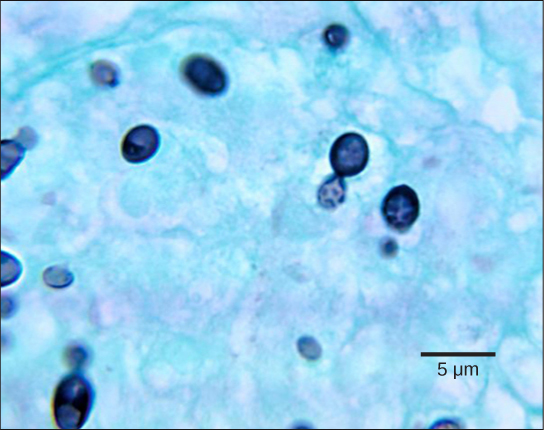
The most common mode of asexual reproduction is through the formation of asexual spores, which are produced by one parent only (through mitosis) and are genetically identical to that parent (Figure \(\PageIndex{13}\)). Spores allow fungi to expand their distribution and colonize new environments. They may be released from the parent thallus either outside or within a special reproductive sac called a sporangium.

There are many types of asexual spores. Conidiospores are unicellular or multicellular spores that are released directly from the tip or side of the hypha. Other asexual spores originate in the fragmentation of a hypha to form single cells that are released as spores; some of these have a thick wall surrounding the fragment. Yet others bud off the vegetative parent cell. Sporangiospores are produced in a sporangium (Figure \(\PageIndex{14}\)).

Sexual Reproduction
Sexual reproduction introduces genetic variation into a population of fungi. In fungi, sexual reproduction often occurs in response to adverse environmental conditions. During sexual reproduction, two mating types are produced. When both mating types are present in the same mycelium, it is called homothallic, or self-fertile. Heterothallic mycelia require two different, but compatible, mycelia to reproduce sexually.
Although there are many variations in fungal sexual reproduction, all include the following three stages (Figure \(\PageIndex{9}\)). First, during plasmogamy (literally, “marriage or union of cytoplasm”), two haploid cells fuse, leading to a dikaryotic stage where two haploid nuclei coexist in a single cell. During karyogamy (“nuclear marriage”), the haploid nuclei fuse to form a diploid zygote nucleus. Finally, meiosis takes place in the gametangia (singular, gametangium) organs, in which gametes of different mating types are generated. At this stage, spores are disseminated into the environment.
Niche and Habitat
Fungi have colonized nearly all environments on Earth, but are frequently found in cool, dark, moist places with a supply of decaying material. Fungi are saprobes that decompose organic matter. Fungi often interact with other organisms, forming beneficial or mutualistic associations. Many successful mutualistic relationships involve a fungus and another organism.
For example most terrestrial plants form symbiotic relationships with fungi. The roots of the plant connect with the underground parts of the fungus forming mycorrhizae. Through mycorrhizae, the fungus and plant exchange nutrients and water, greatly aiding the survival of both species Alternatively, lichens are an association between a fungus and its photosynthetic partner (usually an alga). More on this is discussed below.
Fungi also cause serious infections in plants and animals. For example, Dutch elm disease, which is caused by the fungus Ophiostoma ulmi, is a particularly devastating type of fungal infestation that destroys many native species of elm (Ulmus sp.) by infecting the tree’s vascular system. The elm bark beetle acts as a vector, transmitting the disease from tree to tree. Accidentally introduced in the 1900s, the fungus decimated elm trees across the continent. Many European and Asiatic elms are less susceptible to Dutch elm disease than American elms.
Decomposers and Recyclers
The food web would be incomplete without organisms that decompose organic matter (Figure \(\PageIndex{15}\)). Some elements—such as nitrogen and phosphorus—are required in large quantities by biological systems, and yet are not abundant in the environment. The action of fungi releases these elements from decaying matter, making them available to other living organisms. Trace elements present in low amounts in many habitats are essential for growth, and would remain tied up in rotting organic matter if fungi and bacteria did not return them to the environment via their metabolic activity.
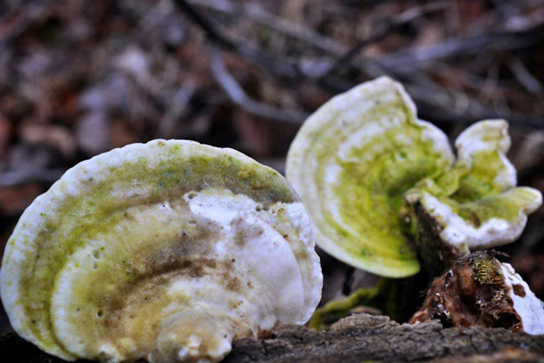
The ability of fungi to degrade many large and insoluble molecules is due to their mode of nutrition. As seen earlier, digestion precedes ingestion. Fungi produce a variety of exoenzymes to digest nutrients. The enzymes are either released into the substrate or remain bound to the outside of the fungal cell wall. Large molecules are broken down into small molecules, which are transported into the cell by a system of protein carriers embedded in the cell membrane. Because the movement of small molecules and enzymes is dependent on the presence of water, active growth depends on a relatively high percentage of moisture in the environment.
As saprobes, fungi help maintain a sustainable ecosystem for the animals and plants that share the same habitat. In addition to replenishing the environment with nutrients, fungi interact directly with other organisms in beneficial, and sometimes damaging, ways (Figure \(\PageIndex{16}\)).
This 4-minute TedEd introduces concepts of energy flow in an ecosystem, including the role of decomposers.
Question after watching: Do humans sometimes eat detritus directly? Provide an example.
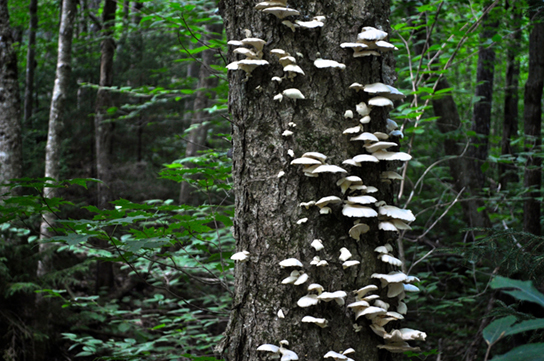
Mutualistic Relationships
Symbiosis is the ecological interaction between two organisms that live together. The definition does not describe the quality of the interaction. When both members of the association benefit, the symbiotic relationship is called mutualistic. Fungi form mutualistic associations with many types of organisms, including cyanobacteria, algae, plants, and animals.
One of the most remarkable associations between fungi and plants is the establishment of mycorrhizae. Mycorrhiza, which comes from the Greek words myco meaning fungus and rhizo meaning root, refers to the association between vascular plant roots and their symbiotic fungi. Somewhere between 80 and 90 percent of all plant species have mycorrhizal partners. In a mycorrhizal association, the fungal mycelia use their extensive network of hyphae and large surface area in contact with the soil to channel water and minerals from the soil into the plant. In exchange, the plant supplies the products of photosynthesis to fuel the metabolism of the fungus.
Lichens are not a single organism, but rather another example of mutualism, in which a fungus (usually a member of the Ascomycota or Basidiomycota phyla) lives in close contact with a photosynthetic organism (a eukaryotic alga or a prokaryotic cyanobacterium) (Figure \(\PageIndex{17}\)). Generally, neither the fungus nor the photosynthetic organism can survive alone outside of the symbiotic relationship.
This 5-minute video provides an overview of mycorrhiza.
Question after watching: What are some of the functions of the common mycelium network?

What term describes the close association of a fungus with the root of a tree?
- a rhizoid
- a lichen
- a mycorrhiza
- an endophyte
- Answer
-
C. a mycorrhiza
Mycorrhizae are the mutually beneficial symbiotic association between roots of vascular plants and fungi. A well-accepted theory proposes that fungi were instrumental in the evolution of the root system in plants and contributed to the success of Angiosperms. The bryophytes (mosses and liverworts), which are considered the most primitive plants and the first to survive on dry land, do not have a true root system; some have mycorrhizae and some do not. They depend on a simple rhizoid (an underground organ) and cannot survive in dry areas. True roots appeared in vascular plants. Vascular plants that developed a system of thin extensions from the rhizoids (found in mosses) are thought to have had a selective advantage because they had a greater surface area of contact with the fungal partners than the mosses and liverworts, thus availing themselves of more nutrients in the ground.
Fossil records indicate that fungi preceded plants on dry land. The first association between fungi and photosynthetic organisms on land involved moss-like plants and endophytes. These early associations developed before roots appeared in plants. Slowly, the benefits of the endophyte and rhizoid interactions for both partners led to present-day mycorrhizae; up to about 90 percent of today’s vascular plants have associations with fungi in their rhizosphere. The fungi involved in mycorrhizae display many characteristics of primitive fungi; they produce simple spores, show little diversification, do not have a sexual reproductive cycle, and cannot live outside of a mycorrhizal association. The plants benefited from the association because mycorrhizae allowed them to move into new habitats because of increased uptake of nutrients, and this gave them a selective advantage over plants that did not establish symbiotic relationships.
Fungal Parasites and Pathogens
The production of sufficient good-quality crops is essential to human existence. Plant diseases have ruined crops, bringing widespread famine. Many plant pathogens are fungi that cause tissue decay and eventual death of the host (Figure \(\PageIndex{18}\)). In addition to destroying plant tissue directly, some plant pathogens spoil crops by producing potent toxins. Fungi are also responsible for food spoilage and the rotting of stored crops. For example, the fungus Claviceps purpurea causes ergot, a disease of cereal crops (especially of rye). Although the fungus reduces the yield of cereals, the effects of ergot's alkaloid toxins on humans and animals are of much greater significance. In animals, the disease is referred to as ergotism. The most common signs and symptoms are convulsions, hallucination, gangrene, and loss of milk in cattle. The active ingredient of ergot is lysergic acid, which is a precursor of the drug LSD. Smuts, rusts, and powdery or downy mildew are other examples of common fungal pathogens that affect crops. Aflatoxins are toxic, carcinogenic compounds released by fungi of the genus Aspergillus. Periodically, harvests of nuts and grains are tainted by aflatoxins, leading to a massive recall of produce. This sometimes ruins producers and causes food shortages in developing countries.
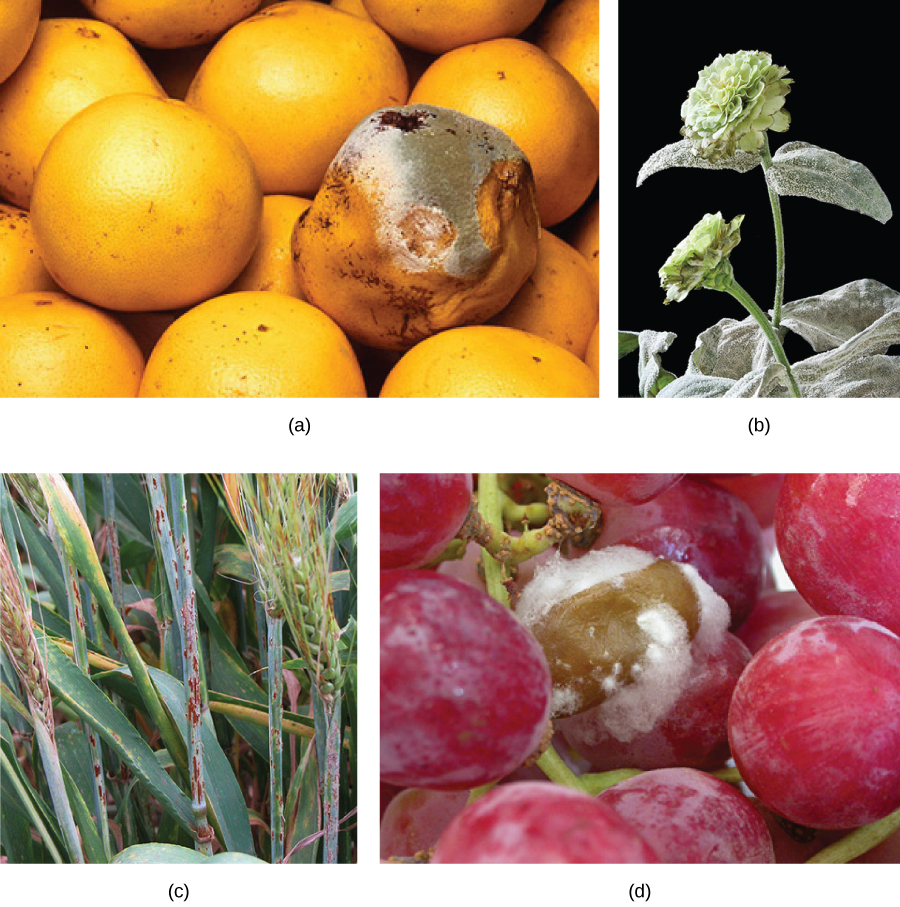
Animal and Human Parasites and Pathogens
Fungi can affect animals, including humans, in several ways. A mycosis is a fungal disease that results from infection and direct damage. Fungi attack animals directly by colonizing and destroying tissues. Mycotoxicosis is the poisoning of humans (and other animals) by foods contaminated by fungal toxins (mycotoxins). Mycetismus describes the ingestion of preformed toxins in poisonous mushrooms. In addition, individuals who display hypersensitivity to molds and spores develop strong and dangerous allergic reactions. Fungal infections are generally very difficult to treat because, unlike bacteria, fungi are eukaryotes. Antibiotics only target prokaryotic cells, whereas compounds that kill fungi also harm the eukaryotic animal host.
Many fungal infections are superficial; that is, they occur on the animal’s skin. Termed cutaneous (“skin”) mycoses, they can have devastating effects. For example, the decline of the world’s frog population in recent years may be caused by the chytrid fungus Batrachochytrium dendrobatidis, which infects the skin of frogs and presumably interferes with gaseous exchange. Similarly, more than a million bats in the United States have been killed by white-nose syndrome, which appears as a white ring around the mouth of the bat. It is caused by the cold-loving fungus Geomyces destructans, which disseminates its deadly spores in caves where bats hibernate. Mycologists are researching the transmission, mechanism, and control of G. destructans to stop its spread.
The true story of Cordyceps.
Importance of Fungi
Engineers, medical researchers, and designers are utilizing the natural abilities of various fungi for antibiotics, building materials, water filtration, toxic waste cleanup, pest abatement, textiles, and other purposes.
Although we often think of fungi as organisms that cause disease and rot food, fungi are important to human life on many levels. As we have seen, they influence the well-being of human populations on a large scale because they are part of the nutrient cycle in ecosystems. They have other ecosystem roles as well. As animal pathogens, fungi help to control the population of damaging pests. These fungi are very specific to the insects they attack, and do not infect animals or plants. Fungi are currently under investigation as potential microbial insecticides, with several already on the market. For example, the fungus Beauveria bassiana is a pesticide being tested as a possible biological control agent for the recent spread of emerald ash borer.
Fermentation—of grains to produce beer, and of fruits to produce wine—is an ancient art that humans in most cultures have practiced for millennia. Wild yeasts are acquired from the environment and used to ferment sugars into CO2 and ethyl alcohol under anaerobic conditions. It is now possible to purchase isolated strains of wild yeasts from different wine-making regions. Louis Pasteur was instrumental in developing a reliable strain of brewer’s yeast, Saccharomyces cerevisiae, for the French brewing industry in the late 1850s. This was one of the first examples of biotechnology patenting.
Many secondary metabolites of fungi are of great commercial importance. Antibiotics are naturally produced by fungi to kill or inhibit the growth of bacteria, limiting their competition in the natural environment. Important antibiotics, such as penicillin and the cephalosporins, are isolated from fungi. Valuable drugs isolated from fungi include the immunosuppressant drug cyclosporine (which reduces the risk of rejection after organ transplant), the precursors of steroid hormones, and ergot alkaloids used to stop bleeding. Psilocybin is a compound found in fungi such as Psilocybe semilanceata and Gymnopilus junonius, which have been used for their hallucinogenic properties by various cultures for thousands of years.
This 5.5-minute video provides a review of the kingdom Fungi.
Question after watching: What are three things you learned in this section, two things you still have questions about, and one visual you created to summarize your learning?
If symbiotic fungi are absent from the soil, what impact do you think this would have on plant growth?
- Answer
-
Without mycorrhiza, plants cannot absorb adequate nutrients, which stunts their growth. The addition of fungal spores to sterile soil can alleviate this problem.
Thumbnail: A cluster of mushrooms. (Modification of work by Chris Wee).


